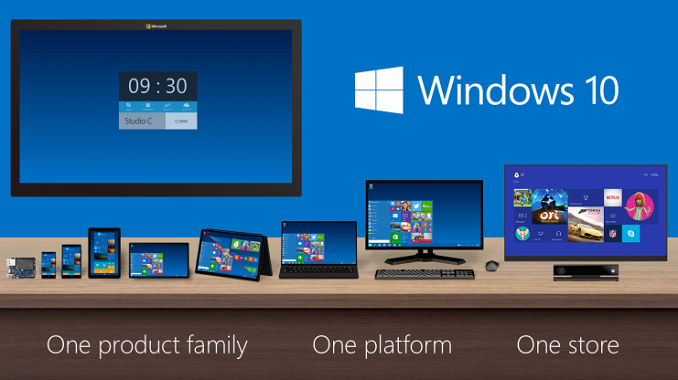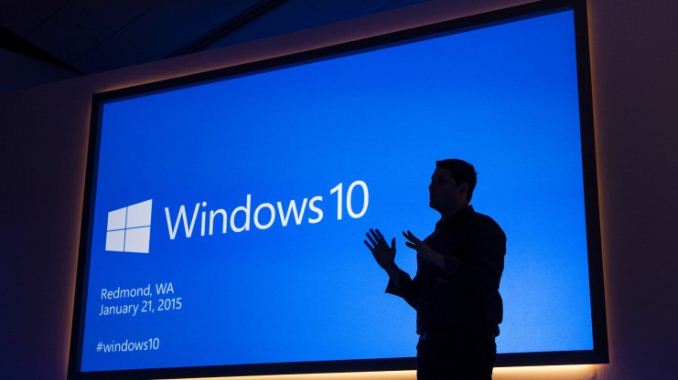Microsoft Announces Free Windows 10 Update
by Brett Howse on January 21, 2015 5:22 PM EST- Posted in
- Operating Systems
- Windows
- Microsoft
- Windows 10

Today Microsoft took the wraps off of their updates to Windows 10, and announced many of the consumer facing features that will be coming with the next version. Likely the biggest announcement of the day came right at the start of the keynote, with a drastic change in the Windows licensing model. There is a lot to discuss, and the keynote itself was over two hours long, so we will cover the rest of the announcements in a separate piece, but due to the significance of this change, it is important to go over the details.
The Windows 10 update will be free for all users of Windows 7 and Windows 8 for one year after launch, which is of course a drastic change over how Windows has been updated in the past. It would be a bit surprising if the free upgrade does not get extended, but for now they are only committing to a free upgrade for a year. However, once updated to Windows 10, the device will kept current and supported over the lifetime of the device. I have already heard “Where is the money going to come from” but really this is sort of a moot point anyway, since the vast majority of people do not pay to upgrade their software anyway. Most of the Windows upgrades come when a person upgrades their device, and at least as far as right now, Windows still has a licensing cost to the OEMs except for some of the smaller, lower cost devices. The initial sale of the device will be the income source, as well as promoting their various online services such as OneDrive, and Office 365, which can bring in subscription based fees. In a way, it is similar to how Apple treats OS X, with the price of the operating system built into the overall system, and then updates can be made available inexpensively going forward.
Really this is about moving the platform forward, and trying to avoid another Windows XP where a large chunk of their user base gets out of sync with the latest versions of software, which causes developers to have to cater to the old platform and not utilize the new features. Windows 7 certainly has the capability of becoming the next Windows XP, so this is an important step if they want developers to build out the new ecosystem.
This is a huge change to Windows, and will move Windows into the realm of being treated as a service. Not only will it move people off of the old platforms much quicker (who does not like free?) it will also allow Microsoft to keep the platform moving forward in the future. The mobile operating systems have already shown how effective this can be, with new APIs and OS features being able to be used by developers much quicker than on the desktop.
This is a key point to moving developers and end users towards the Universal App model, so strategically it makes a lot of sense. If the majority of people are still running a version of Windows that does not support Universal Apps such as Windows 7, it is going to be very difficult to get major developers to build out the platform.
Also, I believe it is also a play towards improving the app situation on Windows Phone. As we will detail in a later piece, Windows Phone is going to be gone, and replaced with just Windows. Windows 10 already has a better mindshare than Windows 8 ever did, so focusing on helping developers build apps that can reach all of their platforms can only help.
Perhaps we now know why Windows 9 was skipped – Windows 10 could be the last major Windows release, with all future versions being an extension of Windows 10.
Source: Microsoft











47 Comments
View All Comments
Ryan Smith - Wednesday, January 21, 2015 - link
The former. Think Macs.dragonsqrrl - Wednesday, January 21, 2015 - link
There's a 1 year period following the launch of Windows 10 when you can upgrade to it for free with an existing Windows 7/8.1 license. So yes, you can get Windows 10 for free as long as you upgrade to it within the first year.Personally I wasn't expecting anything this good. I was thinking maybe 8.1 users might get a free upgrade if they're lucky, but probably something more like a price reduction, and never did I even consider a free upgrade for 7 users a possibility. Don't really know the details behind the upgrade program yet, but I think this is a really good move from Microsoft.
Ikefu - Wednesday, January 21, 2015 - link
They've also said that Windows upgrades will be free forever for the devices you get Windows 10 for. The language is a little odd but it certainly seems like any Windows license you get is now good for all current and future versions of Windows.eanazag - Wednesday, January 21, 2015 - link
I'm sure it will behave like an OEM license where if you change enough hardware it wants to activate again.eanazag - Wednesday, January 21, 2015 - link
The move to 10 from 7 enables a lot of opportunity for BING through cortana and Windows app development. Development that leads to paid app revenue through its store.I thought Apple would be the first to an app being able to run on all device types. It looks like MS will do it.
name99 - Thursday, January 22, 2015 - link
"an app being able to run on all device types"An app being able to run on all device types is, in and of itself, a pretty silly and limited goal.
We've had that for years with web pages, and before web pages we had it with Swing and AWT, and before that we had it with X-Windows and its various toolkits.
And what was the result? In every case, people hated it because no-one wants some half-assed app thats kinda sorta like a real app, but not really.
The difficulty in writing a quality app is not in the backend (which can be written in vanilla C++ and can run anyway), it's in creating a quality UI that takes maximum advantage of the PARTICULAR features of the target, whether that target is a phone, a tablet, or a keyboard+pointing device (or, soon, a watch). MS can't magically make that an easier problem. All they can do is make it possible for an app to run in all the environments, but that does NOT make the app run WELL in all the environments. Compare with iOS phone apps that run scaled up on an iPad, or Android phone apps that run (scaled up in a different way) on Android tablets. They both work, yes; and they both suck. And that's just scaling (without the developer putting in any effort) across touch devices; it gets FAR worse when a pointing device-based app tries to run (without any real effort made in the port) on a touch device, or vice versa.
All MS can do is provide what are essentially the same APIs across devices. Which is, oh my, (basically) EXACTLY the same thing that Apple does. (And, I assume, what Google will do once they finally get their act together and decide how they're going to unify ChromeOS and Android.)
iOS and OSX started life as pretty much identical at the lowest levels, and with the IOS frameworks an updated version of the OSX frameworks stripped either of crud that was realized to be a bad idea, or of complications irrelevant to a small device. Since then, they've only gotten closer as OSX frameworks are reconstructed in the iOS fashion. I expect that, as the frameworks are ported to native Swift, the unification will become pretty much complete.
Brett Howse - Saturday, January 24, 2015 - link
There is a lot more to it than what you are saying. Yes, the APIs need to be on all platforms, which it appears they finally will be with this release. But you are right, you can't have a single app run on all platforms without compromise. That's why a Universal app is not that. It's got common code, but you can add different UIs based on different device types. The backend is the same and the UI is different, but they are all the same "app" in the store, so if you buy once on the phone, you can also use on the desktop and Xbox etc.Here's some info and screenshots http://www.anandtech.com/show/8705/windows-10-tech...
SmCaudata - Wednesday, January 21, 2015 - link
I've had Windows 8.1 crap out on me twice now, the point where I couldn't do a rollback or repair. I had to start over. My windows disk is an original 8 disk and I cannot install 8.1 directly because my CD key won't work.Will this 10 upgrade be the same? They really should make all the old windows keys work so that I can get a 10 image for a flash drive or DVD or something so that I don't have to go through that obnoxious process if I need to re-install the OS.
Brett Howse - Wednesday, January 21, 2015 - link
I've heard rumblings that the latest download of 8.1 allows 8.0 keys entered. I have not confirmed this myself. This is a valid concern though I'll be sure to bring it up when I get a chance.moozoo - Wednesday, January 21, 2015 - link
When will they have Windows 365?I'm also after Visual Studio 365...